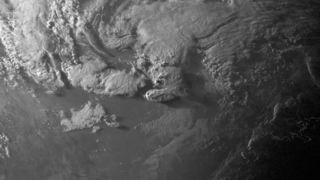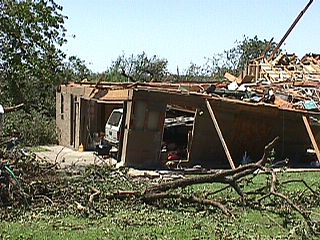
An anticyclonic tornado is a tornado which rotates in a clockwise direction in the Northern Hemisphere and a counterclockwise direction in the Southern Hemisphere. The term is a naming convention denoting the anomaly from normal rotation which is cyclonic in upwards of 98 percent of tornadoes. Many anticyclonic tornadoes are smaller and weaker than cyclonic tornadoes, forming from a different process, as either companion/satellite tornadoes or nonmesocyclonic tornadoes.

This page documents the tornadoes and tornado outbreaks that occurred in 2007, primarily in the United States. Most tornadoes form in the U.S., although some events may take place internationally, particularly in parts of neighboring southern Canada during the summer season. Some tornadoes also take place in Europe, e. g. in the United Kingdom or in Germany.

This page documents notable tornadoes and tornado outbreaks worldwide in 2001. Strong and destructive tornadoes form most frequently in the United States, Bangladesh, and Eastern India, but they can occur almost anywhere under the right conditions. Tornadoes also develop occasionally in southern Canada during the Northern Hemisphere's summer and somewhat regularly at other times of the year across Europe, Asia, and Australia. Tornadic events are often accompanied with other forms of severe weather, including strong thunderstorms, strong winds, and hail.

A violent severe weather outbreak struck the Southeast on April 4–5, 1977. A total of 22 tornadoes touched down with the strongest ones occurring in Mississippi, Alabama, and Georgia. The strongest was a catastrophic F5 tornado that struck the northern Birmingham, Alabama, suburbs during the afternoon of Monday, April 4. In addition to this tornado, several other tornadoes were reported from the same system in the Midwest, Alabama, Georgia, Mississippi and North Carolina. One tornado in Floyd County, Georgia, killed one person, and another fatality was reported east of Birmingham in St. Clair County. In the end, the entire outbreak directly caused 24 deaths and 158 injuries. The storm system also caused the crash of Southern Airways Flight 242, which killed 72 and injured 22.
On May 24–25, 1957, a tornado outbreak primarily affected the Western High Plains, Central Great Plains, and Central Oklahoma/Texas Plains of the United States. 45 tornadoes touched down over the area, most of which took place across northern and western Texas, in addition to southern Oklahoma. Overall activity initiated over eastern New Mexico and spread northeastward as far as southwestern Wisconsin. The strongest tornado, which occurred in southern Oklahoma on May 24, was assigned a rating of F4 near Lawton. Anomalously, some tornadoes touched down during the early morning hours, rather than late afternoon or early evening, when daytime heating typically peaks.

This page documents the tornadoes and tornado outbreaks of 1999, primarily in the United States. Most tornadoes form in the U.S., although some events may take place internationally, particularly in parts of neighboring southern Canada during the Northern Hemisphere's summer season, as well as Europe. One particular event, the Bridge Creek-Moore, Oklahoma F5 tornado, produced the highest wind speed ever recorded on Earth, which was 301 ± 20 mph (484 ± 32 km/h).

From May 3 to May 11, 2003, a prolonged and destructive series of tornado outbreaks affected much of the Great Plains and Eastern United States. Most of the severe activity was concentrated between May 4 and May 10, which saw more tornadoes than any other week-long span in recorded history; 335 tornadoes occurred during this period, concentrated in the Ozarks and central Mississippi River Valley. Additional tornadoes were produced by the same storm systems from May 3 to May 11, producing 363 tornadoes overall, of which 62 were significant. Six of the tornadoes were rated F4, and of these four occurred on May 4, the most prolific day of the tornado outbreak sequence; these were the outbreak's strongest tornadoes. Damage caused by the severe weather and associated flooding amounted to US$4.1 billion, making it the costliest U.S. tornado outbreak of the 2000s. A total of 50 deaths and 713 injuries were caused by the severe weather, with a majority caused by tornadoes; the deadliest tornado was an F4 that struck Madison and Henderson counties in Tennessee, killing 11. In 2023, tornado expert Thomas P. Grazulis created the outbreak intensity score (OIS) as a way to rank various tornado outbreaks. The tornado outbreak sequence of May 2003 received an OIS of 232, making it the fourth worst tornado outbreak in recorded history.

This page documents the tornadoes and tornado outbreaks of 1998, primarily in the United States. Most tornadoes form in the U.S., although some events may take place internationally. Tornado statistics for older years like this often appear significantly lower than modern years due to fewer reports or confirmed tornadoes, however by the 1990s tornado statistics were coming closer to the numbers we see today.

This page documents the tornadoes and tornado outbreaks of 1984, primarily in the United States. Most tornadoes form in the U.S., although some events may take place internationally. Tornado statistics for older years like this often appear significantly lower than modern years due to fewer reports or confirmed tornadoes.

A small but damaging tornado outbreak impacted northern Texas, south-central Oklahoma, northern Louisiana, and northern Alabama in mid-May 2013. The outbreak was the result of an upper-level shortwave trough that tracked across the Southern Plains of the United States. An associated low-pressure area and atmospheric instability resulted in the formation of tornadoes across northern Texas and Oklahoma on May 15. Afterwards the storm system weakened as it tracked eastward, though six additional tornadoes were reported in Texas, Louisiana, and Alabama in the two days following May 15. Over a period of nearly two days, the storm system produced 26 tornadoes in four states. The strongest of these was an EF4 tornado which struck Hood County, Texas on May 15. However, on May 16 and May 17 no tornadoes were confirmed to have been stronger than EF1 intensity. In addition to tornadoes, large hail was reported, peaking at 4 in (10 cm) in diameter near Mineral Wells, Texas on May 15.

This page documents the tornadoes and tornado outbreaks of 1962, primarily in the United States. Most tornadoes form in the U.S., although tornadoes events can take place internationally. Tornado statistics for older years like this often appear significantly lower than modern years due to fewer reports or confirmed tornadoes.

On June 13, 1998, a tornado outbreak occurred across much of the United States. The day saw 45 tornadoes touchdown primarily across Kansas, Nebraska, and Oklahoma. The outbreak saw the Storm Prediction Center outline two Moderate Risk areas in parts of Virginia, North Carolina, and South Carolina, and in parts of Kansas and Nebraska. Additionally, two far more expansive Slight Risk areas were delineated across much of the Central and Eastern United States. By 06:00 UTC June 14, tornadoes had struck parts of six states, including downtown Sabetha, Kansas and parts of North Oklahoma City and the vicinity.

This page documents notable tornadoes and tornado outbreaks worldwide in 2018. Strong and destructive tornadoes form most frequently in the United States, Brazil, Bangladesh and Eastern India, but they can occur almost anywhere under the right conditions. Tornadoes also develop occasionally in southern Canada during the Northern Hemisphere's summer and somewhat regularly at other times of the year across Europe, Asia, Argentina and Australia. Tornadic events are often accompanied with other forms of severe weather, including strong thunderstorms, strong winds, and hail. There were 1,169 preliminary filtered reported tornadoes and 1,121 confirmed tornadoes in the United States in 2018. Worldwide, 17 tornado-related deaths were confirmed; 10 in the United States, four in Brazil, two in Indonesia, and one in Canada.

This page documents the tornadoes and tornado outbreaks of 1958, primarily in the United States. Most tornadoes form in the U.S., although some events may take place internationally. Tornado statistics for older years like this often appear significantly lower than modern years due to fewer reports or confirmed tornadoes.

This page documents the tornadoes and tornado outbreaks of 1954, primarily in the United States. Most tornadoes form in the U.S., although some events may take place internationally. Tornado statistics for older years like this often appear significantly lower than modern years due to fewer reports or confirmed tornadoes.

This page documents the tornadoes and tornado outbreaks of 1953, primarily in the United States. Most tornadoes form in the U.S., although some events may take place internationally. Tornado statistics for older years like this often appear significantly lower than modern years due to fewer reports or confirmed tornadoes. This was the first year to record an F5 tornado as well as one of the deadliest tornado seasons in official U.S. records, which go back to 1950.
This page documents the tornadoes and tornado outbreaks of 1951, primarily in the United States. Most tornadoes form in the U.S., although some events may take place internationally. Tornado statistics for older years like this often appear significantly lower than modern years due to fewer reports or confirmed tornadoes.
This page documents the tornadoes and tornado outbreaks of 1950, primarily in the United States. Most tornadoes form in the U.S., although some events may take place internationally.
An outbreak of seven tornadoes struck the Central Plains and Mississippi in Late-April 1950. Five of the seven tornadoes were significant (F2+), including two violent F4 tornadoes in Texas and Oklahoma, both of which killed five. Overall, the outbreak killed 11, injured 38, and caused $1.575 million in damage. A lightning strike at Lake Texoma in Oklahoma caused an additional fatality and injury as well.















